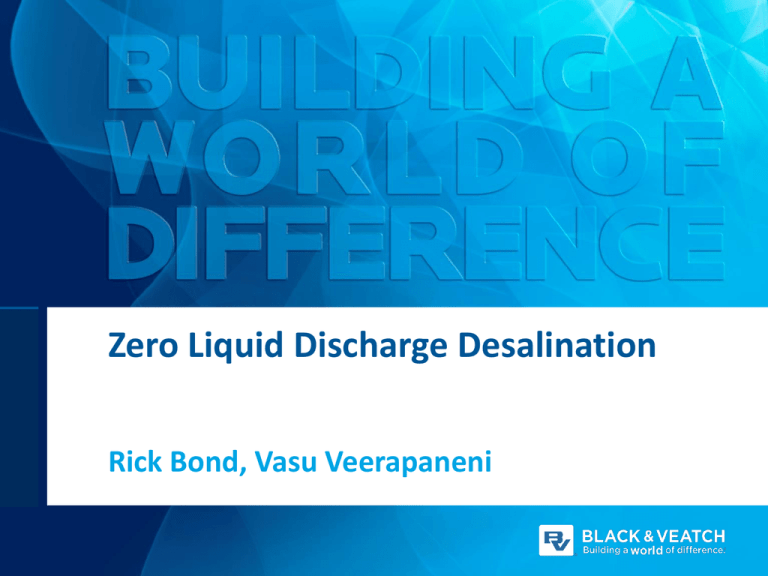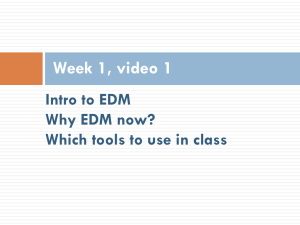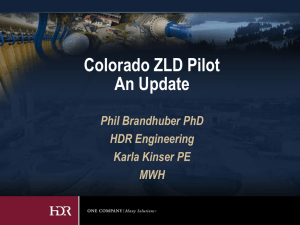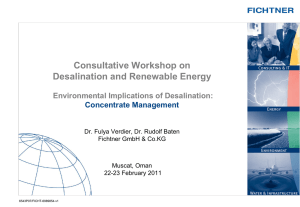Presentation Title - Multi
advertisement

Zero Liquid Discharge Desalination Rick Bond, Vasu Veerapaneni CONCENTRATE MANAGEMENT OPTIONS • Direct discharge to surface water. • Discharge to POTW. • Underground injection. • Zero Liquid Discharge. Discharge options Where discharge is constrained or restricted 2 MOTIVATION TO TREAT AND RECOVER CONCENTRATE • Discharge options that do not remove salt from the water cycle are unsustainable. • Viewed as a resource rather than waste, concentrate can be treated to recover potable water and salt products. • Complete treatment to recover all of the concentrate as potable water is referred to as Zero Liquid Discharge (ZLD) desalination. 3 ESTABLISHED ZLD TECHNOLOGIES ARE EXPENSIVE • Thermal desalination – expensive and energy intensive. Evaporation ponds – expensive, require large land areas, and evaporated water is a lost resource. 4 NEW ZLD APPROACHES HAVE FOUR BASIC STEPS Product Water Primary Desalination Concentrate Recovery in RO is limited by sparingly soluble salts Concentrate Treatment Secondary Desalination salts Concentrate is treated to remove salts Final ZLD Evaporation salts Allowing further recovery by desalination 5 COSTS ARE MINIMIZED BY MAXIMIZING RECOVERY IN SECONDARY DESALINATION Product Water Primary Desalination Concentrate $2 -$3 /kgal Concentrate Treatment Secondary Desalination salts Final ZLD Evaporation $13 /kgal salts 6 Final ZLD Evaporation Secondary Desalination Concentrate Treatment TECHNOLOGY OPTIONS Chemical Softening RO Thermal Fluidized Bed Crystallizer Electrodialysis Reversal Electrodialysis Metathesis Evaporation Pond Ion Exchange MIEX Coagulation Activated Alumina Vibratory ThermoMembrane Capacitative Shear Ionic Enhanced Distillation Distillation Desalination Process Salt Gradient Solar Pond Wind aided intensified evaporation (WAIV) Dewvaporation Biological Forward Osmosis Turbomister 7 RECOVERY IN SECONDARY DESALINATION IS LIMITED BY MEMBRANE FOULING • Inorganic scalants - CaCO3, BaSO4, CaSO4, SiO2. • Natural organic matter (NOM). • Fouling potential of NOM is increased by complexation reactions between NOM and Ca. 8 TWO DIFFERENT APPROACHES WERE EVALUATED IN RESEARCH CONDUCTED TO REDUCE ZLD COSTS • Zero Liquid Discharge for Inland Desalination • AwwaRF Project #3010 (2005 – 2007) • Brackish groundwater, surface water, reclaimed water • Zero Liquid Discharge Desalination of Waters with High Organic Content • Water Research Foundation Project #4163 (2008 – 2010) • Brackish water with high concentrations of natural organic matter 9 ZLD WITH FLUIDIZED BED CRYSTALLIZATION (PROJECT #3010) Primary RO Product Water Product Water Filter Secondary RO Concentrate Fluidized bed crystallizer Brine Concentrator Concentrate Evaporation pond 10 FLUIDIZED BED CRYSTALLIZER (CRYSTALACTOR) • Ca and Ba are removed by precipitation onto CaCO3 crystals. • Used extensively in Europe for softening. • Produces near anhydrous crystals (90% dry) therefore low solids volume. • High loading rate, (80 m/h (33 gpm/sf) small footprint. 11 FLUIDIZED BED CRYSTALLIZER VS. CHEMICAL SOFTENING 1.2 Test 2 = Chemical softening Test 3 = Fluidized bed crystallizer Fraction remaining 1 Calcium and barium removals in fluidized bed crystallizer at pH 8.3 comparable to those in chemical at pH 10.5. 0.8 0.6 Ca Test 2 Ca Test 3 Ba Test 2 Ba Test 3 0.4 0.2 0 7 8 9 10 11 12 pH 12 TREATMENT COSTS WERE REDUCED BY 50 TO 60 PERCENT $14.00 Treatment cost ($/kgal) $12.00 $10.00 $8.00 $6.00 $4.00 $2.00 $BH SNWA COP Benchmark process Scott SAWS Evaluated process 13 ENERGY CONSUMPTION WAS REDUCED BY 65 TO 75 PERCENT Percent reduction (kWh/kgal product) 100% 80% 60% 40% 20% 0% BH SNWA COP Scott SAWS 14 ZLD DESALINATION USING ELECTRODIALYSIS METATHESIS (EDM) (PROJECT #4163) Primary RO product water product water EDM concentrate concentrate Pond, WAIV, or thermal salts 15 ELECTRODIALYSIS METATHESIS (EDM) IS A NEW ELECTRODIALYSIS TECHNOLOGY • Innovative arrangement of membranes used to separate concentrate into two streams of highly soluble salts. • Although this variation is new, the technology and the membranes have been used for decades. 16 ELECTRODIALYSIS IS A MEMBRANE SEPARATION PROCESS DRIVEN BY ELECTRIC POTENTIAL • Driving force is electric potential between anode and cathode. • Cell pair comprises cation and anion exchange membranes, diluate cell, and concentrate cell. • Ions are extracted from diluate compartment and held in concentrate compartment. cation exchange membrane anion exchange membrane diluate - - (+) - - + + anode - • A stack contains hundreds of cell pairs. + + + feed electrolyte solution concentrate - + (-) - + + - cathode + concentrate diluate compartment concentrate compartment repeating cell pair 17 IN BASIC ELECTRODIALYSIS ALL REMOVED IONS ARE CONTAINED IN A SINGLE CONCENTRATE STREAM Cell pair CaSO4 BaSO4 CaCO3 Diluate Concentrate C C A Mg2+ (+) anode Na+ Cl- (-) SO42- cathode Ca2+ Concentrate Feed 18 EDM CONCENTRATE IS SEPARATED INTO TWO HIGHLY SOLUBLE STREAMS Cell set (4 membranes, 4 cells) Na with anions Cl with cations C A SC SC SA Mg2+ (+) Cl- (-) ClNa+ Na+ anode cathode SO42- NaCl Concentrate 1 Na with anions Ca2+ Feed Concentrate 2 Cl with cations NaCl 19 SOLUBILITIES OF NA2SO4, CACL2, AND NACL ARE 15 TO 35 TIMES SOLUBILITY OF CASO4 Solubility of Salts in water CaCl2 Maximum 3.1M at 33°C NaCl Na2SO4 CaSO4 20 DEVELOPMENT OF SOLID PRODUCTS WITH EDM APPROACH product water Primary RO recycled NaCl NaCl recycled to EDM concentrate NaCl EDM NaOH NaOH Pond, WAIV, or thermal CaSO4 CaCO3 Mg(OH)2 salt 21 EDM WATER QUALITY RESULTS • EDM effectively separated the concentrate into two streams of highly soluble salts. • Silica and TOC went through EDM largely unaffected and therefore posed no membrane fouling risk. • No inorganic or organic compound concentrations were found in any of the EDM streams that would be considered potential membrane fouling threats. 22 EDM PILOT RESULTS WITH NF CONCENTRATE Analyte EDM Feed Concentrate 1 Concentrate 2 Calcium 284 51 14,900 Magnesium 69 5 2220 Sodium 376 38,600 14,000 Chloride 853 38,800 53,700 Sulfate 421 42,400 nondetect Bicarbonate 29 350 nondetect TOC 19 36 2 EDM concentrate was effectively separated into two streams of highly soluble salts: sodium with anions and chloride with cations. 23 EDM RECOVERY IN THE PILOT TESTS EXCEEDED 99% Concentrate Source EDM Recovery Rate of water transfer (mol/eq) NF 99.9% 7.7 RO 99.8% 7.4 EDR 99.9% 8.2 NF 99.9% 7.6 Recovery in EDM depends of the rate of water transfer by osmosis and electroosmosis. The rate of water transfer in electrodialysis is proportional to the equivalents of ions transferred. 24 EDM RECOVERY DECREASED WITH TDS 100% 97% at 1400 mg/L TDS 87% at 5300 mg/L TDS EDM recovery 80% 76% at 27,700 mg/L TDS 60% 40% 0 5000 10000 15000 20000 25000 30000 Raw water TDS (mg/L) 25 EDM ENERGY CONSUMPTION INCREASED AS TDS INCREASED 140 y = 0.004x + 2.432 R² = 0.977 EDM energy (kWh/kgal) 120 100 80 60 40 20 0 0 5000 10000 15000 20000 25000 30000 Raw water TDS (mg/L) 26 EDM TREATMENT COSTS COMPARED WITH THERMAL $45 R2 = 0.97 ZLD treatment cost ($/kgal) $40 EDM less expensive $35 Transition range Thermal less expensive $30 $25 R2 = 0.99 $20 $15 $10 $5 $0 5000 10000 15000 20000 25000 30000 Raw water TDS (mg/L) EDM thermal 27 EDM METHOD WAS PARTICULARLY COST EFFECTIVE FOR LOW TDS SOURCES ZLD Treatment Cost $ per 1000 gal Concentrate EDM vs. Thermal Treatment cost ($/kgal concentrate) $12.00 $10.00 $8.00 $6.00 EDM Thermal $4.00 $2.00 $560 630 750 1412 Raw Water TDS (mg/L) 28 SUMMARY • Concentrate management will become increasingly important as we strive to manage salinity and meet water demands. • Two ZLD methods were evaluated in AwwaRF/WRF research projects: fluidized bed crystallization and EDM. • Each showed potential to reduce ZLD treatment costs by more than 50 percent. • Best ZLD method may depend on water quality characteristics and treatment goals. 29 ACKNOWLEDGEMENTS • City of Phoenix • Orlando Utilities Commission • City of Scottsdale • Tampa Bay Water • San Antonio Water & Sewer • South Florida WMD • City of Beverly Hills • Southwest Florida WMD • SNWA • St. Johns River WMD • California Energy Commission • Water Research Foundation 30 MSSC 2011 Annual Salinity Summit FEBRUARY 17-18 SAN ANTONIO, TEXAS Zero Liquid Discharge Desalination Rick Bond BondRG@bv.com 31







